This article originated with an interview with the ‘current’ John Lord, to whom the ODHS expresses its grateful thanks.
The following video clip shows John Lord (known as John Lord (3) for the purposes of this article) recounting an anecdotal story on the demise of one of his ancestors.
The John Lords
This article briefly presents an introduction to two former John Lords of Olney. The first was a successful brewster at the turn of the nineteenth century, the second a well-respected public figure and farmer at the turn of the twentieth century. A third John Lord, still very much with us at the turn of the twenty-first century, provided the impetus to generate this article. It seems that John is head of the sole remaining family of Lords residing in Olney who can be traced back to the earlier two John Lords.
It would appear that a definitive tree for the Lord family has yet to be produced. Moreover, other researchers have found that establishing a satisfactory family tree has proved to be somewhat challenging. One reason was that the Lord family through the generations, probably reflecting a trait of their day, were extremely economical with their allocation of Christian names. John, William and George are used prolifically for sons, whilst Elizabeth and Sarah are used almost exclusively for elder daughters. Consequently, placing names from censuses etc, in the correct generation is somewhat difficult. Nevertheless, a family tree has been compiled and is shown below as it provides some basis from which to identify the relative positions in the history of the three John Lords.
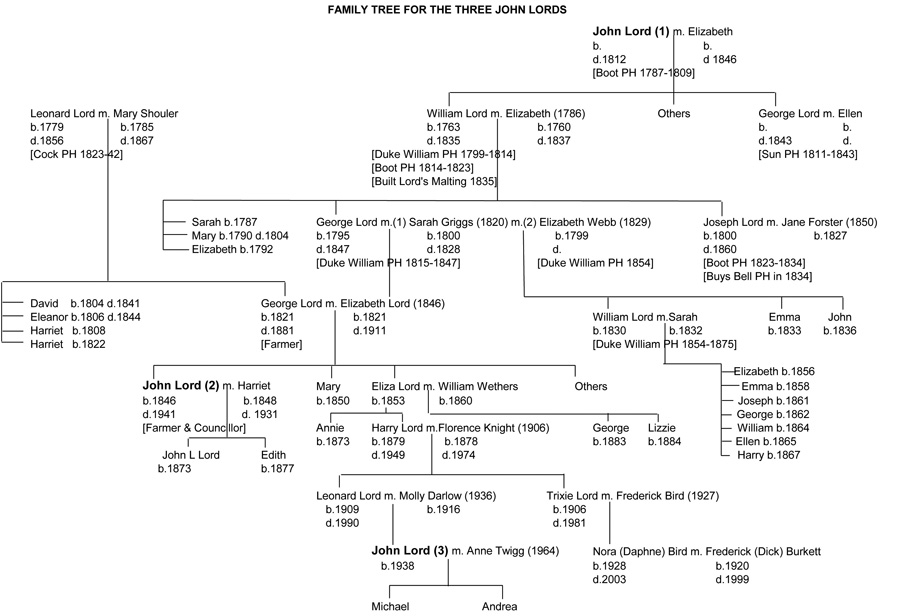 The Olney and District Historical Society gratefully acknowledges a series of notes compiled by Elizabeth Knight, upon which the material for the ‘first’ John Lord is largely based; also Elizabeth’s book entitled ‘The Old Inns of Olney’ published in 1981. Acknowledgement is also given to Robyn Smith for her extensive information on the Lord family, and which sets the scene for the ‘second’ John Lord. Further information was extracted from The Bucks Standard newspaper and from a recorded interview with our ‘third’ John Lord in October 2003.
The Olney and District Historical Society gratefully acknowledges a series of notes compiled by Elizabeth Knight, upon which the material for the ‘first’ John Lord is largely based; also Elizabeth’s book entitled ‘The Old Inns of Olney’ published in 1981. Acknowledgement is also given to Robyn Smith for her extensive information on the Lord family, and which sets the scene for the ‘second’ John Lord. Further information was extracted from The Bucks Standard newspaper and from a recorded interview with our ‘third’ John Lord in October 2003.
John Lord (1)
The first of our three John lords, referred to as John Lord (1) in this article, was presumed to be born in Weston Underwood, date of birth unknown. Records can support that some ‘Lords’ lived in Weston Underwood in the mid eighteenth century. In William Cowper’s time, Samuel Teedon, a friend of the poet and a teacher in Olney, wrote in his diary “whilst at Weston, Mrs. Lord brought Cowper some roast beef down from the farm”.
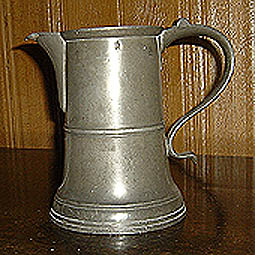
A pewter quart-sized measuring jug owned by John Lord (1)
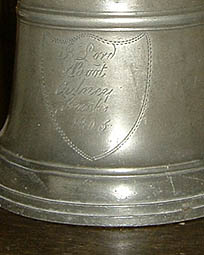
The inscription under the spout reads ‘J Lord Boot Oulney Bucks 1805’
John Lord (1) is generally acknowledged to have developed the first extensive brewing business in Olney. He, his family and close relatives owned some seven public houses, The Boot, The Bell, The Sun, The Duke William, The Cock, The Dolphin and (at the south end of the town) The Red Lion.
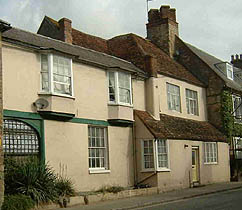
The former Boot Inn – Bridge Street
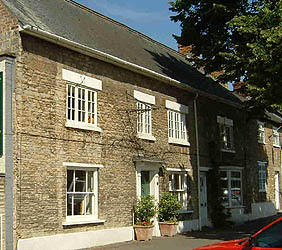
The former Duke William Inn – High Street
John Lord (1) came to Bridge Street in 1787 and opened the Boot public house which had been converted from two cottages and is now Pembroke House. He purchased the property later, in 1804, and also built a stone house on the corner with Lime Street. By 1809 the total number of premises had developed into quite an enterprise and included a brew-house, coke-house, cistern-house, chambers, stables and pigsties.
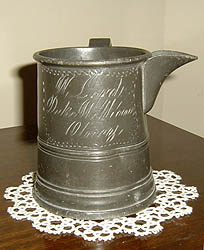
A pewter pint-sized measuring jug owned by William Lord. The inscription reads ‘W Lord Duke William Olney’.
In 1811 John Lord (1) purchased The Sun in Dag Lane, Weston Road, and a George Lord, probably a younger son, became landlord. Again, there are no baptismal or marriage records in the parish register to confirm the relationship. After George Lord’s death in 1843, his wife Ellen continued as landlady.
John Lord (1) was Church Warden in 1803 and 1806. He left a ten shilling mortuary (a fee paid to the church on the death of a parishioner) after his death in 1812. There is no burial record so presumably he was buried in the parish in which he was born, possibly Weston Underwood.
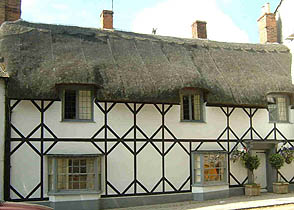
The former Sun Inn – Weston Road
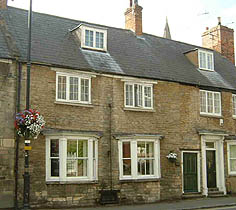
The former Bell Inn – Bridge Street
Not unexpectedly, some family movements took place after the death of John Lord (1). (Refer to the family tree above to avoid becoming totally confused!) His son, William Lord, came to The Boot from the Duke William. He was registered as landlord until 1823, and then William’s son, Joseph, took over. Joseph continued into the 1830s and in 1834 bought the Bell opposite. In 1846 Joseph and his brother George sold both The Boot and The Bell. These pubs were sold again in 1861 to William Hipwell.
William, son of John Lord (1), built the malting at 104 High Street, possibly just before he died in November 1835. The date of 1 August 1835 can still be seen carved into an old warship’s beam along with the names of two carpenters. Subsequently, this building has always been known as Lord’s Malting. It is now business premises.
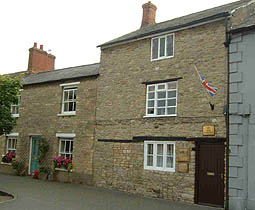
The former Lord’s Malting – High Street (East side)
When William, son of John Lord (1), moved to The Boot, The Duke William was taken over by this William’s son, another George Lord. George married Sarah Griggs in 1820 but sadly, she died in 1828. George then married Elizabeth Webb, and remained at the Duke William until his death in 1847. This second wife (Elizabeth) is recorded as landlady in 1854. George and Elizabeth’s son, another William, had then come of age and able to take over the public house as landlord. His wife was also called Sarah. They eventually sold the Duke William in 1875 and had a house built on the opposite side of the street, the present 102 High Street.
‘It is more difficult to establish to what extent John Lord (1) or his relatives owned the remaining three of the seven public houses. Evidence and hearsay suggest that from 1823 to 1842 the landlord of the original Cock public house in Silver End was a Leonard Lord who married a Mary Shouler (see the family tree). Both Leonard and Mary were born in Weston Underwood, and although a generation or so younger, could have been fairly closely related to John Lord 1. Leonard died in 1856 and Mary survived him, dying in 1867.
The Red Lion, in High Street South, was later owned by a son of Leonard Lord, another George Lord. George was a farmer and married Elizabeth Lord, the great grand daughter of John Lord 1 (best refer to the family tree again!). He died in 1881, but Elizabeth lived into the 20th century, dying in 1911.
In 1823 the landlady of the Dolphin (nowadays 21 High Street South), was a Mary Lord also probably closely related to John Lord 1 and or perhaps Leonard Lord. Her name does not appear on the Family Tree but further research may unearth more information.
John Lord (1) appears to have been an ambitious brewster. Unfortunately, following his death in 1812, his brewery operations appeared to become fragmented amongst his family. Had the business continued under John Lord 1, it is possible that it would have expanded further and as a consequence it probably would not have been viable for the Hipwells to develop their brewery interests in Olney. However, his apparent early death paved the way for them eventually to buy all seven public houses in the 1860s and 1870s. Judging by the grand dwellings that the Hipwell’s later built in Olney, there was still a fortune to be made in brewing.
Of the seven public houses attributed to ownership by the Lord family, none survive as licensed premises today. Nevertheless, as the photographs testify, the buildings of The Boot, The Duke William, The Rising Sun, The Bell and Lord’s Malting still exist and should survive into the foreseeable future. The buildings housing the original Cock, Red Lion and the Dolphin have long since disappeared.
John Lord (2)
John Lord (2) was born in 1847 in Near Town. He is listed as a domestic gardener in the 1881 Census and as a farmer in the 1891 Census. He married Harriet, a dressmaker. They had a son, John L, born in 1873 and a daughter, Edith, born in 1877. John L is listed in the 1891 Census as a dairyman.
John Lord (2) was the son of George Lord and Elizabeth Lord (see the family tree again!), and consequently a grandson of Leonard Lord and Mary Shouler, and a great-great-grand son of John Lord 1.
Census information suggests that John Lord (2) inherited a 28 acre farm from his father, George Lord. The farm was believed to include land near the church, and around Near Town and Silver End. It included the Cattle Market, now a car park, and the old Fairfield, now Fairfield Close off East Street. Kelly’s Directory 1911 lists him as a farmer and his son, John L, as a dairyman and cow-keeper. John Lord 2 obviously increased his farming activities over the years as there is evidence to suggest that he farmed land in Emberton and off West Street.
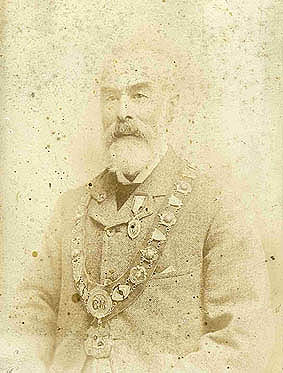
John Lord (2) as Provincial Grand Master of the Manchester Unity of Odd Fellows (Wellingborough District)
John Lord (2)’s interests included many activities in addition to farming. For example, the School Board for Olney was formed on 23 March 1875 and according to Oliver Ratcliffe’s book published in 1907, John Lord (2) was comfortably elected to one of the seven member positions on the School Board in 1887, 1893, 1896, 1899, and 1902. He was obviously elected several more times, as the Olney Board School diary of January 10th 1911 records that as a Member of the School Board he again visited the school to audit the school registers.
Around 1887 (ref: Oliver Ratcliffe’s 1887 Almanac) John Lord (2)’s other interests included Secretary to the Cowper and Newton Book Club and Secretary to the Earl of Dartmouth Lodge of Oddfellows. The 1891 Census records indicated that he was an Enumeration Officer.
Around 1895, John Lord (2) was instrumental in forming the Olney Parish Council. Again, according to Oliver Ratcliffe, he was comfortably elected onto the Parish Council (as it then was) in 1896 and in 1904. His career as a Parish Councillor obviously developed because in 1921 he officiated at the unveiling ceremony for the War Memorial where, as Chairman of the Parish Council he accepted the memorial on behalf of the Town.
His career as a Rural District Councillor may have been a little slow in starting as he was narrowly defeated in the 1904 election and did not contest the election in 1907. However, he must have been successful in later elections. The Bucks Standard weekly newspaper dated 8th March 1890 reported on a meeting in the British School held under the auspices of the North Bucks Conservative Association. The list of those present included John Lord 2, which indicated his probable political persuasion.
John Lord (2) died in 1941, two days after his 94th birthday. A comprehensive obituary appeared in The Bucks Standard on Saturday 5th April 1941 and is summarised below:
Son of George and Elizabeth Lord, he was born on Lady Day, 1846, at Near Town, Olney. That was ten years after the accession of Queen Victoria to the throne. A man with a very retentive memory, he often recalled happenings of his boyhood days, and the stories he had to tell of events in Olney three-quarters of a century and more ago were always interesting. He often spoke of the great fire which raged in the town when he was only a boy and which he viewed from a wall in Spring Lane. This left such an impression on his mind that when in later years the proposal to establish a fire brigade in Olney, so as to give greater security to life and property was put forward, it had his warmest support. He was a pioneer in the movement which gave to the town its fire fighting service in 1878, and he became a member of it on its formation and saw many years active service. So great was his interest that he never allowed the fireman’s plate to be removed from the front of his house, and one of his greatest joys in the closing days of his long life was to see the Brigade, for which he had done so much, reorganised and equipped both with men and material on a really businesslike footing.
Friendly Society work appealed to him, and for 75 years he had been a member of the Lord Dartmouth Lodge of the Manchester Unity of Odd Fellows, passing through all the chairs to the office of Provincial Grand Master of the Wellingborough District and had attended ten Moveable Conferences of the Order. For 29 years he served the Olney Lodge as Secretary, and an interesting and unique feature of his 75 years membership was that never once did he receive sick pay.
For many years, up to 1916, he was engaged in farming. He was tenant of the Hungary Hall Farm a short distance from Olney, which was so isolated in those days that it could not even boast an approach road to the farmhouse. He was acknowledged to be a good and practical farmer. For a long period he had the oversight of Lord Dartmouth’s estate. He was one of the two last surviving founders of Olney Stock Market, and for quite a quarter of a century was chairman of the committee, which position he resigned in 1938, when he was succeeded by Mr W Stewart of Weston Underwood. His interests in agricultural pursuits was so great that even after he gave up active farming he continued his association with the poultry side of the industry and was a successful breeder of chickens, ducks and geese.
Mr Lord served on many public bodies in his day. From 1912 to 1922 he represented his native town on the Newport Pagnell Board of Guardians and Rural District Council; was a member of Olney Parish Council for several years and for a period was chairman of that body; a member of the old School Board; and one of the overseers of the parish. In all these offices he served the townspeople well. He was also a director of the Olney Gas Company, and Hon. Secretary of the Cowper and Newton Book Society.
In his public and private life Mr Lord won the respect of his fellow townsmen.
Perhaps the above final sentence says it all! The floral tributes, as recorded in The Bucks Standard, included ‘a posy from little John Lord’ presumably our John Lord 3.
John Lord 3
The relationship between John Lord (2) and John Lord (3) appears to be (see family tree) that John Lord (2)’s sister Eliza Lord is John Lord (3)’s great grandmother.
A complication arises because Eliza Lord apparently had a son, Harry Lord, ‘out of wedlock’. Eliza later married William Wethers and had two more children, George and Lizzie. The rest of the family tree is then straightforward. Harry Lord married Florence Knight in 1906 and had a daughter, Trixie, in 1906 and a son, Leonard, in 1909. Leonard Lord married Molly Darlow and had a son, John, in 1938, our John Lord 3.
For the record, John Lord (3) is probably the five times great grandson of John Lord (1), or some seven generations down the family tree as shown. John Lord (3) is married to Anne Twigg, an Olney girl.
John is quite sanguine concerning the rise and fall of his Olney ancestors, noting that none of the inheritance from the earlier John Lords came his way and was probably exhausted several generations back. After all, he says, Olney was always considered to be a relatively poor community, as it was supported only by the poorly paid shoe and lace industries and agriculture. Moreover, Olney had numerous public houses where the ‘demon drink’ could be had for solace!
John tells the following anecdotal tales of his ancestors. After he came back from the First World War, Harry Lord, John’s grandfather, worked in the leather business at the Tannery. He later became a night watchman at the Tannery and actually died there. In his spare time he was a poacher, probably one of the best in the district. He poached anything, deer, pheasants, rabbits, and anything else that could be put in the pot. At that time, of course, there was a good chance of being shot by the gamekeeper. As the laws were pretty strict on poaching in those days, he was fined several times at Newport Pagnell Magistrates Court. John reckons that was a shame because there was plenty of game to be had locally.
Another relative of his grandfather’s generation was a dairyman and delivered milk around the town. When on his milk round he was well known for stopping at the pubs for a drink. Unfortunately one winter’s day he slipped, fell on some ice and broke his leg. He later died in hospital, some said, probably because he was starved of drink.
John’s grandfather, Harry Lord, married Florence Knight in 1906. They lived at No. 8 East Street; which is still in the family today. Florence became an experienced lace maker and made Bucks Lace until well into her eighties. Florence died in 1974.
John’s father Leonard, on leaving school, worked for a time in Billy Abbott’s travelling fair. He married Molly Darlow from Gamlingay in Bedfordshire. Later, he worked in the leather industry at Harold for some 30 years, where his job included tanning snake-skins. John says that his father’s work was quite poorly paid and probably little better than that of the average agricultural worker. In his father’s earlier days in the leather industry, the shoe industry in Olney mainly comprised subcontractors. For the most part women were employed in small factories scattered throughout the town. A large number of these units have survived and examples can be seen in West Street and in the north end of East Street. Also at this time, outworkers (mostly men) used purpose-built workshops in their back gardens to produce leather goods. Many of these workshops have also survived in certain terraces of houses in the town; for example, at the rear of the Feoffee Cottages and Beauchamp Terrace houses in Dartmouth Road.
John is of the opinion that the anecdotal tales regarding the poaching and drinking escapades of his ancestors were largely true and typical of life in Olney at that time. The inherent, but subconscious, oppression within the cultural hierarchy at that time did little to improve the state of poverty that remained in Olney for so long. In John’s view, the general prosperity of Olney did not significantly improve until after World War II, and particularly with the advent of Milton Keynes, which he considers has been highly beneficial to the people of Olney.
References:
The Diary of Samuel Teedon (1791 to 1794), edited Thomas Wright 1902
Oliver Ratcliffe, Ratcliffe’s 1887 Almanac
Oliver Ratcliffe, Olney Bucks 1907
Elizabeth Knight, The Old Inns of Olney, published 1981
The Bucks Standard, 5th April 1941
Acknowledgements:
To Elizabeth Knight and Robyn Smith for unpublished information on the Lord family.
.
Copyright © 2005 Olney & District Historical Society
